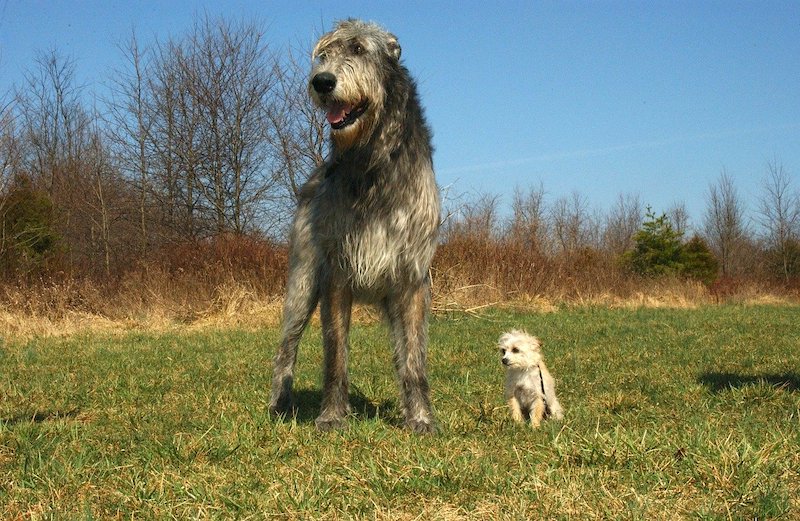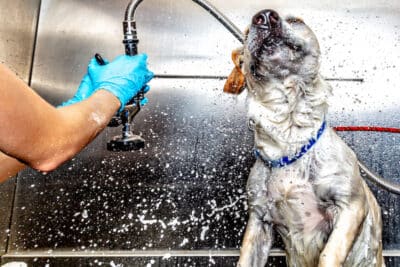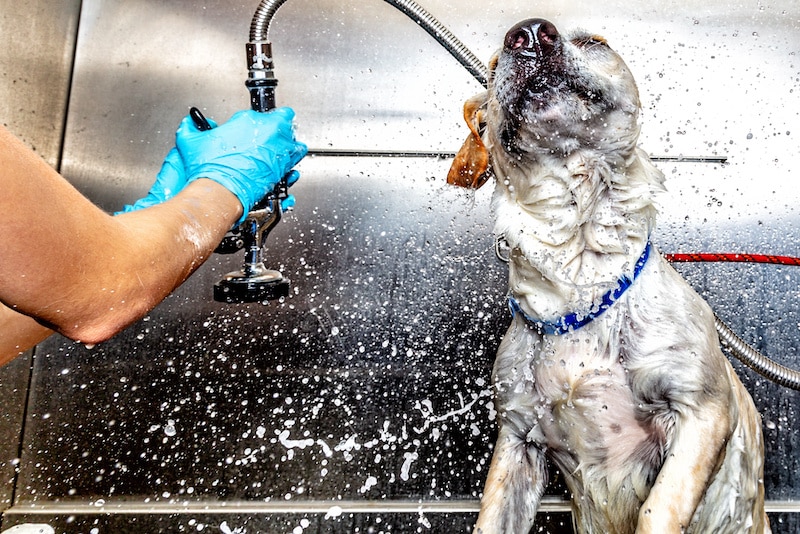Irish Wolfhounds are a tall sighthound that was once used as a wolf hunter in Ireland. They are strong, courageous and independent, but make loyal and peaceful companions.
What about shedding? Irish Wolfhounds shed an average amount of hair and, while they do have an undercoat, don’t shed seasonally like most double coated breeds. Brushing is fairly straightforward too, a slicker brush and undercoat rake is all you need to maintain his coat and keep shedding to a minimum.
Let’s look at how much they shed in more detail, along with what it takes to maintain their coat and what makes them such amazing companions.
Irish Wolfhound Shedding
Irish Wolfhounds shed an average amount of hair year round.
To help put this into perspective, they shed about the same amount as their close relative, the Scottish Deerhound, less than a Great Dane, and more than a Whippet.
They have a rough top coat that is longer and more wiry around the eyes and jaw, along with a dense undercoat that helps keep him warm in winter and cool during summer.
However, unlike most double coated breeds, like the Bernese Mountain Dog for example, Irish Wolfhounds don’t shed seasonally during spring and fall.
This is normally a time when shedding in double coated breeds picks up to very high levels as their coat prepares for the change in season, but thankfully that is not the case with a Wolfhound.
They are a large breed though, which does impact shedding. In fact, they are tallest breed the American Kennel Club (AKC) has on record, standing a huge 30-32 inches tall. So, even though they don’t shed seasonally, and the rate at which they shed isn’t extreme, the mere size of the dog means they have more hair to lose than a smaller breed.
So expect to find loose hairs floating around the home. The good news is, it’s not hard to get this under control through a simple routine of brushing, so let’s take a look at how this is done.
Recommended: Go here to see our top-rated dog hair blow dryers
What Are Wolfhounds Like to Groom?
The Wolfhounds coat is fairly easy to maintain, it mostly comes down to brushing regularly with a good slicker brush and undercoat rake. And if you don’t know what these are, check out this article where I compare the different types of dog brushes.
You will notice that Wolfhounds in the show ring are professionally groomed, but this isn’t necessary for the average person to do. A brush once or twice per week is enough, or more if you’re noticing more hair around the home than you’d like to see.
Start with a slicker brush to work out any matts they might have, and the majority of dead hairs on their top coat. And finish up with a deshedding tool, comb or undercoat rake to remove the loose fur from his undercoat.
This process isn’t difficult, but it does take time, especially if you’re new to the whole grooming thing. But it’s well worth the effort because, again, brushing is your best defence against shedding.
Other grooming requirements include the regular tasks such as bathing, nail trimming, cleaning their teeth and so on. Nothing out of the ordinary, just stuff you should do regularly to keep your Wolfhound in good shape.
Are Irish Wolfhounds Hypoallergenic?
No, Irish Wolfhounds are not hypoallergenic.
And the reason is because, while not extreme, they do lose some hair on a regular basis. The hair itself often isn’t the sole cause of the allergies, the dander (or dead skin) and dried saliva is.
However, allergens like dander naturally attach themselves to the dogs hair, and when that hair falls out and gets airborne, it can cause issues for people who suffer from allergies like asthma for example.
So, given they shed only moderately, they’re certainly not the worst breed you could get if you suffer from allergies. But they are not going to be as good as a hypoallergenic breed like the Basenji for example.
The reality is that no dog, regardless of how much they shed, is every truly hypoallergenic. It’s just that some are more “allergy friendly” than others.
Tips to Reduce How Much They Shed
If you’re concerned about how much your Wolfhound is shedding and want to reduce this, then the good news is that this is possible. You can’t stop it, because all dogs shed, but you can minimize it.
And the main way to do this is by removing the hairs from the source, by brushing. The more dead fur you can remove, before it covers your furniture, clothing and floors, the better.
I think that’s pretty obvious though. But that you may not know, is that brushing can also help to prevent excessive shedding due to a dry coat.

How? Well, like humans, dogs have oil on their skin, and when you brush your dog, you are helping to spread this oil evenly over his coat. Which increases the level of moisture within their skin and hair, naturally reducing the amount of hair they will lose from dryness.
You can also help to reduce shedding caused by dry skin in other ways like ensuring your Wolfhound is consuming a well rounded, quality dog food. And by not bathing him too often.
Anything more than one bath per month is probably overkill and can cause dryness, especially if you’re not using a good quality dog shampoo, so this is something to keep in mind.
You can learn about other ways to reduce shedding here.
Should You Adopt an Irish Wolfhound?
It’s hard to go wrong with an Irish Wolfhound, they’re an excellent breed, but there are some things to keep in mind when weighing up the pros and cons of adopting one.
For example, they can become quite destructive if left alone for extended periods of time. So they probably aren’t suited to someone who is away a lot. But on the same token, they aren’t known to bark very much, so won’t howl much while you’re away.
They’re also very large dogs, and as such, require a lot of food to keep them satiated. Which of course means they aren’t the cheapest breed to care for. So make sure owning a Wolfhound is in your budget.
With that being said, they do make loyal, loving family companions. And even though they can be a little intimidating, are typically good with kids and even strangers, provided the latter doesn’t provoke them. They may be gentle, but they’re a forced to be reckoned with if provoked.
Also, it’s important to understand that they are a sighthound and that hunting is in their blood. Which is also the case with breeds like the Greyhound and Scottish Deerhound. Which, along with the Great Dane, are breeds the Irish Wolfhound is closely related to.
They’ve hunted elk, boars, deer and wolves in their time, and even helped soldiers fight in the war. So, while they’re typically very placid, they may give chase to small, fast moving animals like cats. But with proper training and socializing early on, this shouldn’t be an issue.
So if you’re looking for a tall, loyal, relaxed family dog, that will love being part of the family, and you don’t mind a moderate amount of shedding, the Irish Wolfhound could be right for you.













Please note: By submitting a comment using the above comment form, you confirm that you agree with the storage and handling of your data by this site as detailed in our Privacy Policy.